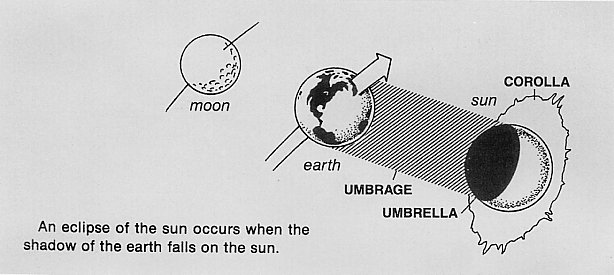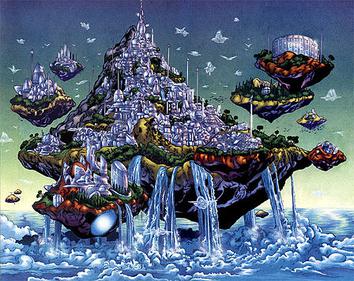Chapter 8: Campaign Design

There's something fundamentally wrong with Spelljammer's cosmology.
Campaigns are hard to design. I mean, you can string along any series of adventures with the same player characters and call that a "campaign," and it technically is. But a campaign usually implies some sort of overarching plot or interconnection between the adventures, and that is more difficult - because Mister Cavern not only has to keep the players' interest throughout, and try to keep their player characters involved in adventure after adventure, but the PCs' actions and inactions should theoretically have some impact later on in the campaign. That's really hard to have happen well without railroading, because player characters tend not to be very...proactive.
Spelljammer has the additional problem in that the setting is...it doesn't have a focus. I mean, Dungeons & Dragons, you expect dungeons. Dungeoneering. It doesn't have to be exclusively dungeon-delving, but it's the expectation. The first D&D "series" modules were largely a series of dungeons. But Spelljammer is all about getting out of the dungeon. The author seems to understand this obliquely in emphasizing that space is BIG, although in a strictly cosmic sense it is not, in fact, very big at all, since it takes less time to travel between planets than it takes most ships to travel to different continents in the medieval world. But whatevs.
This 19 page chapter (1 physical page longer than the organizations one, my apologies for claiming otherwise earlier) starts out admitting that running a campaign of this shit is in fact Nintendo Hard. Basically, once you get your spelljammer ship you can pretty much go wherever the fuck you want, but there isn't really any reason to go anywhere in particular. There aren't established trade routes or important ports of call or even lists of key goods for arbitrage. The planet you're from is largely unexplored and uncivilized and the other planets you might choose to visit are also largely unexplored and uncivilized. As a player, you might as well just go wherever the space winds may take you, but if one of the other players wants to go to Zanzibar to meet the Zanzibarbarians, there's no particular reason to veto that.

Who hired this crew?
So while there's definitely an age of sail exploration rush vibe going on, it's equally true that the Europe in this metaphor is an unmapped iron age hellscape with no Papal Peace. So you could very definitely explore alien lands with exotic goods and strange customs by traveling to the next county rather than to the next solar system. When Toril is already a giant clusterfuck full of fallen empires and unimagined treasures and savage monsters, what exactly is the point of sailing off to Oerth supposed to be? The author doesn't actually seem to know.
The author suggests only that your campaign should have some sort of theme. Suggested themes are Merchants, Explorers, The Resistance, Mercenaries, Pirates, and The Law. These are all stretching the nautical theme a bit, but they'd all be serviceable. At least, they would be if hypothetically there was any support for any of this shit. I mean, how can we be Merchants or Pirates when we don't have even a vague list of what goods are worth something in any of the places we might intend to offload them? How can we be the plucky Resistance against the space empire when none of the planets have any global hegemony to overthrow?
The spacefaring economy is at best a “cottage industry.” Despite the discussion in this book about trade between the spheres, almost all trade occurs within a single crystal sphere. Only the rarest and most precious items are worth shipping long months across the phlogiston. There is no stock cargo that can be sold anywhere. Remember, the civilizations within the spheres have worlds to plunder for their goods.

Sure.
This is basically a total failure to understand age of sail economies. If there are goods that people want that require multi-month journeys through perilous areas using expensive and specialized vehicles, then you can bet your fucking ass that those goods are going to be expensive. That is how economies work. If the people of Krynn want to eat Torilian Hiexel Fruits, they are going to pay what it takes to get them. And what it takes to get them is enough wealth to entice people to travel several months through the stars dodging murderoids and giant space hamsters to bring them. That is what the cost is going to fucking be. And that would be, I should think, a pretty fucking large number.
Really, for this setting to make any sense at all or be useable in any way, we'd need a few pages talking about goods and services that are relatively cheap or expensive in different areas of the setting. And that would be a lot of work because even single planets have areas filled with stone age Quaggoth and areas with crystal science Ilithid and everything in between. But this book doesn't even try. The author is so stuck in late twentieth century thought that he hits a stop codon when he realizes that there isn't a common currency on different planets. Yes! We aren't buying and selling things in an advanced economy, we are arbitraging trade like in the age of sail! Throw me a frickin bone here!
The thing about space travel in a science fiction context is that there's sort of an assumption that you will encounter less-advanced civilization that do not have space travel, equally advanced civilizations that also have space travel but maybe different exact capabilities, and more-advanced civilizations that you are at a technological disadvantage against. However, in D&D the technology level is closer to "rule of cool" than anything else, and because Spelljammer wasn't designed to upset the major settings it slots into, it has to have minimal impact. This is not a good recipe for applying any of the normal science fiction tropes to.
And this isn't necessarily a problem limited to Spelljammer. It's the same sort of issue you would have with a Stargate-themed campaign where you have a portal network between worlds. The logistics are different, but you're still looking at the same sorts of conflicts and goals, and it still runs into the same problems when it comes to D&D: logically, if you have travel between worlds, if it is at all economical to trade goods, services, and/or information, then there should be such trade...at some level...unless there is a very good reason otherwise (say, a Cold War ban between Oerth and Toril...but who the fuck would get behind that?)
But then again, it would be logical to have golems powered mills. It comes back to one of the fundamental issues with D&D: people didn't want a living, realistic setting. They wanted a quasi-medieval setting with magic that was "rare" but still readily available to player characters. Frankly, Spelljammer introduced more problems than it did answers; it cast the static nature of D&D settings in stark relief. Spelljamming should have been a game changer. The fact that it wasn't should have been a warning sign to the writers.
We get into the nitty gritty of deciding what kind of ability score selection system to use. 2nd Edition AD&D didn't really have a default choice. Back in the original Dungeons & Dragons you were supposed to roll up a shit tonne of characters using 3d6 in-order to generate ability scores and just accept that lots of those characters would be shitty and die off. As character creation became more work (with choosing kits and assigning proficiencies and shit), the great Darwinian Sieve became less attractive. But 2nd edition never got around to deciding what exactly they intended to do about it. Instead they just wrote up a bunch of character generation procedures that were in no way balanced against each other and said “I dunno, ask your DM which (if any) of these you are using.

Asking DMs is dangerous.
Then we start getting into the chapter ranting at us about how various class features of normal classes are and are not different in space. Didn't we have several pages about essentially this exact subject in chapter 1 when it told us that Blind-fighting wasn't different but probably not all that useful in space back in chapter 1? Yes. But now we get the description of how anti-magical phlogiston shrinks a Paladin's 10' radius protection from evil to a 5' radius protection from evil. Honestly, fuck this book.
The alignment system is unchanged in space.

There's a lot to unpack there, but it's a common element in a lot of RPG think of the period. The PCs were not supposed to be the movers and shakers of the setting. I think this was instinctive anti-Mary Sue-ism, but what it really does is make way for DM penis NPCs armed and armored with Plot. It's why people hated Immortal Elves in Shadowrun, and ultimately it makes for kinda shitty stories. Your PCs should be allowed to be Princess of the Mushroom Kingdom if they want to be. The issue, of course, is that the standard settings (and AD&D's system in particular) are not really set up to handle "important PCs" who have abilities, property, etc. not reflected on their character sheet.In a spacefaring campaign, character backgrounds can be more important than in a groundling campaign.

They also offer a lot of ideas for "character backgrounds," most of which just don't work for 1st-5th level characters. Of course, they also address "zero-level characters," and if you remember that...ah, well. It's back when cats could reliably kill 99 out of 100 NPCs in the setting. Long story short: it was the idea that almost everybody was nobody. So PCs were super special, yet still not important. Take a drink.
I kind of wish they had embraced this. I think D&D can be a lot more fun when the players are allowed to get more creative with their characters. D&D...in space should have been an excuse for some well-intentioned goofiness. I mean, a lot of the promotional materials and fluff for the game kind of convey the idea of Spelljammer as just this crazy place where PCs are out of their element and weird shit happens.In space, weirder is better.

Buck Godot with wizards, basically.
But D&D isn't really built for light-hearted. Which is too bad. One day, perhaps.
I'm not going to count the number of spells that get spot rulings. Each spell gets an incredibly telegraphic description of what the author thinks the correct ruling to a question that is at best implied by the floating answer given here. These answers are so telegraphic and the spells being referenced are often so obscure that I have no idea whether these rulings are reasonable or not. But I'm pretty sure I have never met a DM who would make all these calls the same way.
Because the fire arrows created by this spell are released from a campfire, this spell cannot be cast in the phlogiston.
In general, these seem like mostly kind of dickish spot rulings. Like, apparently you can't use Drawmij's Protection From Nonmagical Gas to refresh the atmosphere in a ship. And Nystul's Expeditious Fire Extinguisher won't put out fires in phlogiston. And Shatterhull only breaches hulls on spelljammer ships when they are floating in water. It's all so fucking random and dickish. I definitely don't want this kind of drive by fuckery to be the last thing I am remembered for.The caster's mental signal that the spell was tripped will not cross the boundary of a crystal sphere, nor will it travel more than a quarter mile in the phlogiston. The skull's audible shriek cannot travel through the void.
For reasons I don't entirely comprehend, the errata for the ghost rigging, wood rot, and shooting stars spells are contained in the spot where they normally put the pithy anecdotes. So I don't know if that's serious or if they thought it merited special attention or if it's some sort of overflow error in layout or not.
I could make an argument for why a lot of the spells are being adjudicated this way - in D&D, a spell wasn't quite like you think of in Shadowrun or Mage. Each spell was its own special snowflake, and it was supposed to basically be its own metaphysical engine taking into account lots of little details of the environment and how it's supposed to work, like the phases of the moon or the size of the emerald you're using as a material component and shit. So spells tended to be a lot more...characterful than utilitarian. I mean each spell, it had its own unique scroll ink whose formula you might have to quest and learn, and if it had material components you could play with those components to see if they changed the effects of the spell - so like gorgon poop might make a more powerful burst of damage than regular bat guano when casting fireball, but in a pinch you could cast the spell by sticking your thumb up your own ass. That kind of thing.
Portions of that survived into D&D3 - most specifically, stuff like metamagic components and power components (which substituted for XP costs). If D&D3.x had been sorted a little better, this could have been integrated into the setting a bit more thoroughly and the system more neatly, a bit like the Rite of AshkEnte in Discworld. But in AD&D, it was a grab-bag clusterfuck of individual efforts. Ironically, this usually meant it was tactically better to load up on obscure spells from hard-to-find supplements, because they were less likely to be errata'd and it was easier to argue with Mister Cavern about what their precise effects were.

Chapter 9: Strongholds in Space

This is where things go full retard.
Strongholds in space is, let's be clear, a very weird idea. I have no idea how you'd defend a fortress in space, considering that people can drop heavy objects on your fortress from any direction. And I don't know what a stronghold in space would actually be good for. Historically, castles are for holding territory, and space – even bullshit SPELLJAMMER® space – is stupidly titanic. How big of a territory could your space castle possibly interdict? And what fucking difference would it make if it did? The distance between any two things you care about is more than the distance between any two points in any other campaign setting can be. You could control an area the size of the largest empire in any setting and we'd still put that entire area on the map with a single pen dot. And we'd only do that because we don't have anything smaller.
So you might think we'd get 11 pages talking about what you'd use a fortress in space for. You do not get that. Instead you get 11 pages telling you how to calculate construction cost modifiers to the rules from the Castle Guide for trying to build a regular castle in a place people can't breathe. Basically, it's a giant WTF?Hitchhiker's Guide to the Galaxy wrote:Space is big. Really big. You just won't believe how vastly, hugely, mind-bogglingly big it is. I mean, you may think it's a long way down the road to the chemist, but that's just peanuts to space.

The Castle Guide was a DMG Reference Series book, I don't know if the author thought it was part of the same book series as the Complete Spacefarers or not. It does not have the word “Complete” in the title. Could go either way.
But yes, it does confirm that ships can tow giant rocks and then let go of them at your fortress and essentially reduce it to rubble at will. I have no idea what the point of building these fucking things is supposed to be.
...I got nothin'. I mean, the Justice League has a space station because it's cool and it helps them keep track of shit going on on Earth. I can see how making your own Space Clubhouse might be cool if you have one of the few spelljammers in your sphere and you want to really be outside of catapult range of all the people you pissed off on your home planet. Maybe you want to play Deep Space 9 or Babylon 5 with actual elves and dwarfs instead of Vulcans and Naar. Don't get me wrong: having a space pad is pretty fuckin' cool.

But it's a bit like having your own demiplane. It's a place to keep your stuff, sure, but other than that, are you ready for all the ancillary costs and time that go into home maintenance? Can't you just rent a nice keep on the outskirts of a lunar city or something?
There are like costs for barbicans and shit. I can't even fucking process this shit. You live in a 3 dimensional environment where everyone and everything can come from any angle.

You are in space and everyone flies. They can just bypass your stupid fucking barbican.
We don't even approach answering questions like what a god would need with a starship spacefarer would need with a castle. We haven't even gotten to answering questions like “what would a space castle even look like?”
To be fair, a lot of these are just talking about building castles on irregular worlds. Like, you can't build a wooden castle on a fireworld. That seems straightforward enough. You can also just build a little shack and a road like on King Kai's planet, for when you retire.

Froody.
It also has a random events table you roll on monthly during construction. FFS. These range from a labor dispute ("They don't even get dental!") to getting 1d6 minutes warning that a space missile is going to hit your new space crib. It's a bit like being Donald Trump in space, and I'm a little queasy just saying that.
My mind is still full of fuck. Fortunately, this is the end of the book. There are BATTLESYSTEM® rules in here and I just don't have the energy to make fun of this shit.

We literally get a page and a half of bad rules and then go straight to the index. Some of the suggestions include mining (because, presumably, nobody expects you to come from the position with the strongest natural obstacle to movement), destroying the air supply by aiming for the plants that supply the atmosphere (if you can hit a 10' x 10' patch of plants, can't you just destroy the fucking space castle?), and talk about just dragging an asteroid to impact the thing and being fucking done with it.
After that, it's an ad for the RPGA network and then the back cover.
I don't know if we're going to do a wrap-up post for this book, but I'm just going to throw this out here: what the fucking-fuck is the point of it? You read "The Complete Spacefarer's Handbook" and maybe you think it'll have resources for spacefarers, but mostly it was a couple of kits you won't use, some proficiencies that if you were going to take them should have been in the boxed set, some spell rulings that will make you cry, a bunch of shit about groundlings, and some half-assed incomplete rules for building a space castle. I was hoping for...I dunno. Useful kits and proficiencies. New gear. Additional space-based resources to take advantage of. Maybe some new spells. Handy monsters. I'm not necessarily asking for a chariot drawn by Giant Space Hamsters, but I would have preferred that to the fucking Xenos.
It had some new PC races. This is good. I mean, obviously, they should have been options available in the main rulebook. But take what I can get, weird space-apes and all. But it just feels like such a random grab-bag assortment of stuff...it's not even the cutting room floor material, is it? There's no real theme at all, aside from "Okay, here's some random stuff for your Spelljammer game, I guess." I mean, say what you will about the D&D3 Complete series - and they were rubbish - but they largely tried to stay on-topic as far as aiming to provide resources for a specific subset of players. Shitty resources, often, but work within your theme. This book just seems so...random.
